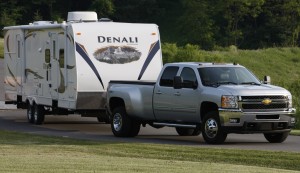Does Main Street know something Wall Street doesn’t? That’s a question observers are asking as they explore the minutiae of the September U.S. auto sales figures. Overall sales posted a strong upturn – reaching their highest annualized rate since last April – buoyed in part by demand for pickups and other light trucks.
That jump clearly was linked to the sharp decline in fuel prices – buyers in some parts of the country now seeing pumps set below $3 a gallon – but it may also indicate a renewed optimism among America’s working class. These days, the so-called personal use truck market has largely dried up, most pickup buyers actually using their vehicles for works.
“It’s definitely a positive sign,” said David Sullivan, auto analyst with AutoPacific, Inc. “I think the increase…says things may not be as bad as all the doom and gloom we’re hearing.”
During September, the annualized sales rate increased to 13 million, a surprising upturn considering the crash on Wall Street and steady news coverage of what could be the beginning of a double-dip recession. While overall new vehicle sales rose 10%, the figures were even bigger in the various light truck segments, which together captured 54% of the market, the biggest percentage for all of 2011.
While SUVs gained ground, the more significant increase involved large pickups – including the Ford F-Series, Chevrolet Silverado, GMC Sierra, Ram, Toyota Tundra and Nissan Titan. Collectively, they accounted for 13.7% of total new vehicle sales. That was up from 12.0% in August and, perhaps more significantly, marked the highest level in three years.
That was particularly good news for the domestic makers, Toyota continuing to feel the pinch of production constraints stemming from the March 11 Japanese earthquake and tsunami, noted Rod Lache, lead auto analyst with Deutsche Bank.
Analysts are debating precisely what is driving the full-size pickup market. There are falling fuel prices, for one thing, which have tumbled as much as $1 a gallon in some parts of the country. But the figures are still, on average, about $1 more than what motorists were paying in September 2010. And studies show that buyers no longer view fuel prices as a short-term issue. Most anticipate costs will rise in the coming year, perhaps sharply, so the current downturn is generally seen as a temporary reprieve.
There’s also the issue of “pent-up demand,” according to analyst Sullivan, the fact that many buyers who would like to buy – or need to buy – a vehicle have been waiting to see the economy improve or perhaps have been sitting on the sidelines because of their own personal job situation.
But there comes a point where you may no longer be able to wait, industry experts contend. And that’s becoming a fact of life for many as their vehicles continue to age. According to registration data gathered by R.L. Polk and Associates, the average American light truck is now 10.1 years old, a record.
“A commercial owner cannot afford to have their vehicle out of service,” said Don Johnson, GM’s vice president of U.S. sales, during a Monday morning conference call with journalists.
What helps encourage potential buyers is the flood of new products and high-mileage powertrains. Chrysler has introduced a low-priced version of its heavy-duty Ram pickup. The Ram 1500 Tradesman will be targeted at “hard-working people” who need an affordable full-sized offering, said Chrysler’s Fred Diaz, during its launch earlier in the year.
Ford, meanwhile, is gaining significant traction for its 2011 F-Series models, the majority of which are now being purchased with V-6, rather than the traditional truck V-8s.
Nonetheless, “Who’s doing the buying? Are they buying a new truck because the old one is worn out?” asks Joe Phillippi, founder of AutoTrends Consulting. The simple fact, he says, is that, “If they’re not working they’re not buying.”
So, the increase in large pickup (along with commercial van) sales could be a positive sign that the Main Street economy is picking up even if the situation on Wall Street is dire.


“So, the increase in large pickup (along with commercial van) sales could be a positive sign that the Main Street economy is picking up even if the situation on Wall Street is dire.”
Nice spin on the Obama economy. But I vote for pent-up demand and a need to buy. That’s reality.
Randy, history shows that pent-up demand remains just that unless people feel they either 1) have no choice — your “need to buy”; or 2) they see things improving enough to at least risk, if not encourage, the investment. And, frankly, the facts don’t support your need-to-buy argument as the primary cause as we would have been more likely to see that earlier in the year when the market was, overall, turning upward. There’s nothing to suggest that some sort of collective failure of vehicles has occurred that suddenly, in Sept., people needed to go out and buy a lot of pickups.
All that said, I think there are a variety of explanations, but I think the public may not, as one analyst put it, “be worrying about the situation in Greece.” They’re more worried about their local community, and if they’re getting orders to build a new deck or install a lawn full of sod after no orders for six months they may be more willing to invest. (Okay, make those orders plural.)
I don’t think you’d be willing to take an opposing view under any circumstance with this admin, but the issues are clearly worth exploring. If this were the downturn in the final Bush admin I have a feeling you’d be more open to such a question.
Paul E.
Why do you think I am or was a Bush supporter? Because I’m a conservative? Nonsense!